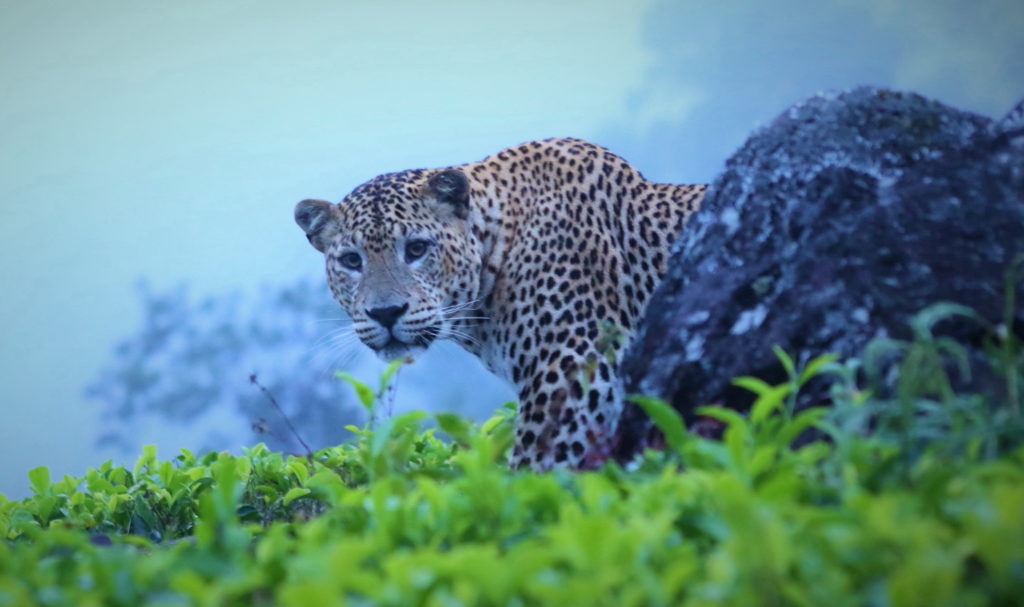Photo courtesy of the Wildlife & Nature Protection Society
The leopard is a big cat in the genus Panthera (Panthera pardus) that has a distribution throughout sub-Saharan Africa, through the Middle East and into several countries in Asia. Once occupying a vast contiguous land mass of varied climate and terrain and split into nine distinct subspecies based on genetic variation, even today (although much reduced in both range and numbers) the leopard remains the most widely distributed large feline in the world.
The leopard is the quintessential big cat – a prototype ancestral to all Pantherines was a pre historic feline much like the modern leopard. The leopard remains the most generalized big cat, while the lion, the tiger the jaguar and snow leopard (the other four pantherines) are all more specialized hence less adaptable carnivores.
Of the nine genetically distinct subspecies the Sri Lankan leopard is one of two island sub species. The Sri Lankan leopard, due to its geographical isolation in the island of Sri Lanka, is a restricted range species. Leopards, in general, have an unparalleled ability to adapt to a changing landscape, climate and prey base. Leopards tackle the most diverse prey species of any big cat and are not averse to scavenging. Occupying the apex predator position on the island for millennia, with no competition from other terrestrial carnivores, leopards have benefited and thrived on an island of great faunal diversity and a multitude of habitats.
Today the Sri Lankan leopard faces many challenges, as the island’s population approaches 22 million people and our livestock, farmlands and settlements spread into the far reaches of what was, until recently, wilderness.
When forced to prey on livestock, with the decline of their wild prey, leopards become visible and thereby vulnerable. With this entanglement in human livelihoods, and the entry into farmlands, sparks the beginning of conflict with humans that never ends well for leopards. Wherever this process has exacerbated, due primarily to land use change and illegal hunting of wildlife for bushmeat, leopards are vilified and deliberately killed. Everywhere that leopards live in unprotected lands, they die as the unintended victims of wire snare traps meant for other animals. In addition, leopards die eating poisoned carcasses as well as in deadfall traps and by trap guns. A once abundant cat that ranged throughout the island up to pre historic times is now locally extinct (has been extirpated) from many parts of the country, most significantly from the densely populated south west of the island.
Hope for the future of Sri Lankan leopards lies in the protected area network and its efficient management; the enforcement of the Fauna and Flora Protection Ordinance throughout the country and related prosecutions; and the education of the younger generation as well as current policy makers as to the importance of conserving the leopard which is an ecological and economic asset, that we are fortunate to share this island with.
The long term conservation of the leopard will involve protection, education, conflict mitigation, responsible custodianship and coexistence.
In an effort to promote these principles, the Wildlife & Nature Protection Society (WNPS) canvassed for the declaration of August 1, the date on which a thesis by Dr. Sriyanie Miththapala was published confirming Panthera pardus kotiya as an endemic sub species, to be annually celebrated as Sri Lanka Leopard Day. While Leopard Day will raise the profile of this endangered species in the public’s eye, to address the identified knowledge gaps the WNPS is partnering with LOLC Holdings PLC to establish a network of specialised leopard conservation locations and research centres across geographically important areas. The research centres will focus on understanding the species function in populations or meta-populations that exist at much larger scales than those at individual management units at a regional level. Through this initiative, the WNPS is creating common knowledge and a data sharing platform to drive a research-based islandwide leopard monitoring programme. Through the establishment of these research centres, smaller monitoring efforts will be easily integrated into larger programmes and databases. It will enable scientists and conservationists access to deeper and wider sets of data to understand local leopard populations both regionally and countrywide.
Photos courtesy of the Wildlife & Nature Protection Society
